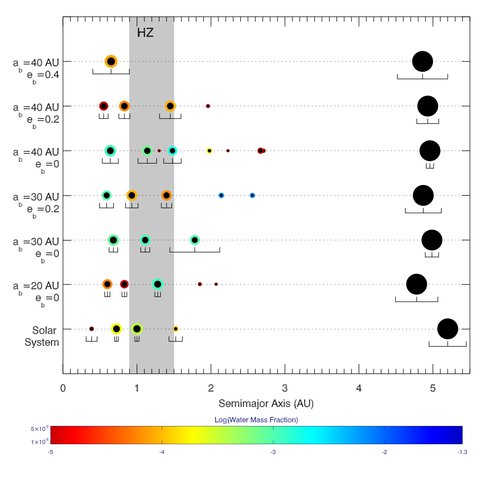2009 Annual Science Report
 University of Hawaii, Manoa
Reporting | JUL 2008 – AUG 2009
University of Hawaii, Manoa
Reporting | JUL 2008 – AUG 2009
Terrestrial and Habitable Planet Formation in Binary Stars
Project Summary
We are studying the formation of Earth-like/habitable planets in binary star systems, in particular those that host a giant planet. We are simulating the formation of these bodies for different distribution of water in a circumstellar disk. With more than 50% of stars in binary systems, it is quite possible that Kepler space telescope may soon find many of such binary-planetary systems.
Project Progress
Haghighipour has been carrying out a systematic study of the formation of habitable planets in the habitable zone of binary-planetary systems. The motivation behind this study comes from the fact that among more than 370 extrasolar planets discovered to-date, approximately 20% are within binary star systems. Among these planetary systems, the three binaries of γ Cephei, GJ 86, and HD41001 are unique in the sense that their separations are smaller than 20 AU, and their primary stars host giant planets. Haghighipour’s study focuses on understanding how migration of giant planets in binary stars affects the formation of Earth-like objects in their habitable zones. In collaboration with John Chambers from NAI/Carnegie, Haghighipour has been simulating the interactions of several hundred Moon- to Mars-sized objects, in a region between the giant planet and the primary of a binary system, for different values of the mass and orbital parameters of the binary, and different migration scenarios. This project is a continuation of the PI’s previous study of the formation of terrestrial planets in binaries. Results indicate that, binary-planetary systems can form and harbor Earth-like objects in their habitable zones, however, the efficiency of these processes are strongly affected by the eccentricity of the binary. As shown in figure 1, in binaries with high orbital eccentricities, the interaction of the secondary star with planet-forming material is strong and results in the ejection of water-carrying objects. As a result, in such systems, final terrestrial planets are mostly dry and un-habitable. However, binaries with lower eccentricity and separations between 20 to 40 AU show a more hospitable environment for the formation and long-term stability of Earth-like planets around their primary stars. Simulations are currently underway to study the effects of planet migration on the results.
This figure shows that Earth-sized planets can form around the primary of a binary star. The amount of water in such planets decreases as the eccentricity of the binary increase.
Publications
- Haghighipour, N. (2008). Habitable Planet Formation in Extreme Planetary Systems: Systems with Multiple Stars and/or Multiple Planets. Exoplanets: Detection, Formation, And Dynamics. Sozhu, China.
- Haghighipour, N. (2009). The Stability and Prospects of the Detection of Terrestrial/Habitable Planets in Multiplanets and Multiple Star System. Extrasolar Planets in Multibody Systems; Theory and Observation. Torun, Poland.
-
PROJECT INVESTIGATORS:
-
RELATED OBJECTIVES:
Objective 1.1
Formation and evolution of habitable planets.


